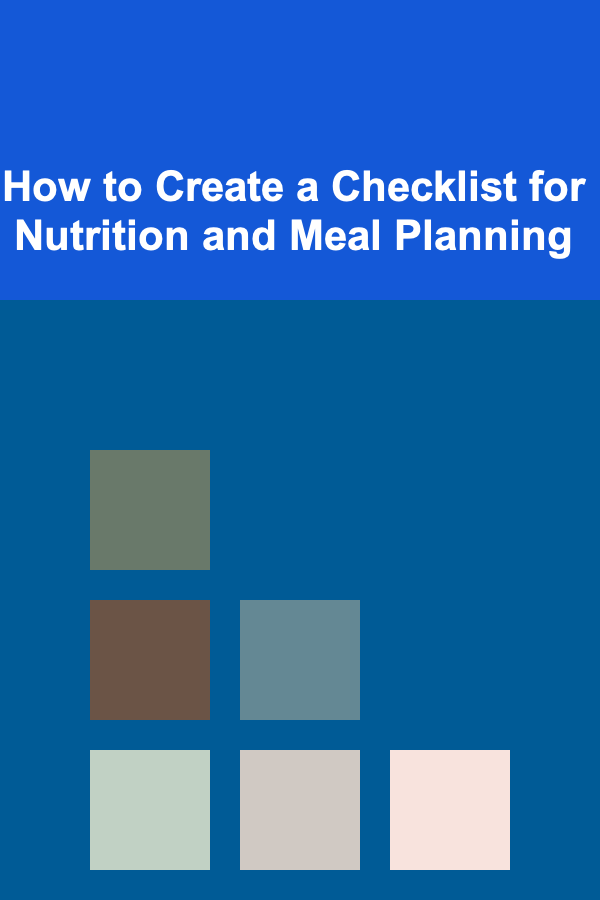
How to Create a Checklist for Nutrition and Meal Planning
ebook include PDF & Audio bundle (Micro Guide)
$12.99$7.99
Limited Time Offer! Order within the next:

Meal planning and nutrition are central to maintaining a healthy lifestyle, but it can often feel overwhelming to ensure that you're meeting all of your dietary needs while also managing the complexity of preparing balanced meals. One effective way to simplify the process is by creating a checklist. A well-organized checklist allows you to stay on top of your nutritional goals, save time, reduce stress, and make informed decisions when planning meals for the week.
In this guide, we'll walk you through how to create a checklist for nutrition and meal planning that is not only easy to use but also tailored to your individual needs. Whether you're focusing on weight loss, muscle gain, overall wellness, or managing a specific condition, the key to successful meal planning lies in setting clear, actionable goals and sticking to them consistently.
Understand Your Nutritional Needs
Before creating a meal planning checklist, it's essential to have a solid understanding of your specific nutritional requirements. Nutrition needs vary depending on factors such as age, gender, activity level, and health conditions. For example, athletes may require more protein and carbohydrates, while someone managing a chronic condition may need to restrict sodium or sugar intake.
Actionable Steps:
- Calculate Your Caloric Needs: Use an online calorie calculator or consult a nutritionist to determine how many calories you need per day to maintain, lose, or gain weight. Your calorie intake will help guide how much food you should plan to eat.
- Identify Macronutrient Ratios : Macronutrients (proteins, fats, and carbohydrates) are the building blocks of your diet. Adjust these ratios based on your health goals:
- For weight loss: Higher protein, moderate fat, and lower carbs.
- For muscle gain: Higher protein, moderate carbs, and moderate fat.
- For overall health: A balanced approach of all three macronutrients.
- Consider Micronutrient Requirements: Vitamins and minerals are equally crucial to your overall health. Ensure you're getting enough of key micronutrients like vitamin D, calcium, iron, and magnesium.
Tools for Tracking:
- Food Diary: Track your daily intake to identify areas where you might be lacking or overconsuming nutrients.
- Mobile Apps: Consider using apps like MyFitnessPal or Cronometer to track both your macronutrients and micronutrients effectively.
Set Your Meal Planning Goals
Once you have a clear understanding of your nutritional needs, the next step is to set concrete goals for your meal plan. This could range from preparing meals for weight loss, building muscle, managing a medical condition, or simply maintaining good health.
Actionable Steps:
- Decide on the Duration: How far ahead do you want to plan your meals? A common approach is to plan meals for a week, but if you prefer, you can plan for a longer or shorter period based on your lifestyle and preferences.
- Choose the Number of Meals per Day: Some people thrive on three larger meals a day, while others prefer smaller, more frequent meals. Choose the frequency of your meals and snacks based on your schedule and hunger cues.
- Set Specific Nutritional Targets: For example, if your goal is to lose weight, you might aim for a daily intake of 30% protein, 30% fat, and 40% carbohydrates. If you're focusing on gaining muscle, the ratio might shift to 40% protein, 30% fat, and 30% carbs.
Create a Meal Planning Template
A meal planning template helps you organize your weekly meals and ensures that you're meeting your nutritional goals. It can be a simple grid where you fill in meals for each day of the week. By doing this, you'll ensure that your meals are balanced and nutrient-dense.
Actionable Steps:
- List Your Meals: Start by writing down breakfast, lunch, dinner, and any snacks. Make sure each meal includes a balance of protein, fats, and carbs.
- Plan for Variety: Variety is key to getting a wide range of nutrients. Don't stick to the same meals every day; instead, try to include different fruits, vegetables, proteins, and grains throughout the week.
- Add Simple Recipes: Choose recipes that are easy to prepare and align with your goals. You don't have to complicate things with intricate dishes---simple, nutritious meals can be just as effective.
Example Template:
- Breakfast: Scrambled eggs with spinach and avocado (protein, healthy fats, fiber)
- Lunch: Grilled chicken salad with mixed greens, quinoa, and olive oil dressing (protein, healthy fats, carbs)
- Snack: Greek yogurt with berries and almonds (protein, healthy fats, antioxidants)
- Dinner: Baked salmon with roasted sweet potatoes and steamed broccoli (protein, healthy fats, carbs)
A well-rounded meal plan should be designed to ensure you're eating the necessary nutrients throughout the day, with an emphasis on whole, minimally processed foods.
Organize Your Grocery List
Once you have a meal plan for the week, it's time to organize your grocery list. This is where your checklist really comes in handy. An effective grocery list should reflect all the ingredients you'll need for your meal plan, organized by category to make shopping more efficient.
Actionable Steps:
- Categorize Your Ingredients: Divide your grocery list into categories such as produce, dairy, meat, pantry items, and frozen foods. This makes it easier to navigate the store and ensures you don't forget any ingredients.
- Consider Batch Cooking Ingredients: Choose ingredients that can be used for multiple meals throughout the week. For example, buying a large bag of spinach that can be used in salads, smoothies, and omelets helps save time and money.
- Avoid Processed Foods: Aim to avoid or minimize processed foods that may be high in added sugars, unhealthy fats, and preservatives. Focus on whole foods like fruits, vegetables, lean meats, legumes, and whole grains.
Example Grocery List:
- Produce: Spinach, sweet potatoes, broccoli, tomatoes, berries
- Dairy: Greek yogurt, eggs, cheese
- Meat: Chicken breast, salmon
- Pantry: Quinoa, olive oil, almonds, canned beans
- Frozen: Frozen peas, frozen berries
Prepare and Cook in Batches
Batch cooking is one of the best ways to save time during the week. By preparing large portions of meals ahead of time, you can simply heat them up as needed. Batch cooking also helps you stay on track with your meal planning goals, as you're less likely to opt for unhealthy takeout or processed foods when you already have homemade meals on hand.
Actionable Steps:
- Cook in Large Quantities: Prepare large portions of proteins (like chicken or salmon) and grains (like quinoa or brown rice) at once. Store them in containers for the week.
- Pre-Prepare Vegetables: Wash, chop, and store vegetables in separate containers so they're easy to throw into salads, stir-fries, or snacks.
- Use Slow Cookers or Instant Pots: These appliances make batch cooking even easier. You can throw ingredients in and let them cook while you focus on other tasks.
Batch Cooking Tips:
- Invest in Quality Storage Containers: Use BPA-free containers that are safe for both the fridge and freezer. Glass containers are often the best choice for preserving food quality.
- Label Containers with Dates: Write the date on each container so you can keep track of when food was made and when it should be eaten.
Stay Flexible and Adjust as Needed
Life doesn't always go according to plan, and neither should your meal plan. While it's important to have a plan, it's also crucial to stay flexible. If you find that you're not enjoying a particular meal or that you're running low on certain ingredients, don't be afraid to make adjustments.
Actionable Steps:
- Swap Ingredients: If you can't find a specific ingredient or don't like it, look for a similar alternative. For example, if you don't enjoy quinoa, try rice or couscous.
- Revisit Your Plan Weekly: At the end of each week, reflect on what worked and what didn't. This will allow you to make informed changes for the next week's plan.
Stay Consistent and Reevaluate
Consistency is key to maintaining any nutrition and meal plan. Stay committed to your checklist and meal planning strategy, but also be open to making improvements. Regularly reassess your goals and adjust your checklist to reflect changes in your lifestyle, fitness progress, or health.
Actionable Steps:
- Track Your Progress: Keep a food diary or use an app to track your progress. Monitor how well you're sticking to your nutritional goals and adjust your plan if necessary.
- Incorporate Feedback: Listen to your body. If you feel sluggish or notice that certain meals don't satisfy you, tweak your checklist for better results.
Conclusion
Creating a checklist for nutrition and meal planning is an essential tool for anyone looking to improve their eating habits and achieve specific health goals. By taking the time to understand your nutritional needs, setting clear objectives, organizing your grocery list, and preparing in advance, you can ensure that you stay on track without the stress of last-minute decisions. Remember, meal planning is not about perfection, but about consistency and flexibility. The more you practice, the easier it will become to enjoy healthy, balanced meals that support your wellness goals.
Reading More From Our Other Websites
- [Personal Care Tips 101] How to Create a Multi-Step Facial Scrub Routine for Flawless Skin
- [Home Lighting 101] How to Create Ambient Lighting Without Overdoing It
- [Home Holiday Decoration 101] How to Create a Warm and Inviting Entryway for the Holidays
- [Home Soundproofing 101] How to Use Weatherstripping for Better Soundproofing
- [Organization Tip 101] How to Choose the Ideal Location for Your Family Reunion
- [Soap Making Tip 101] Eco‑Friendly Soap Making: Sustainable Practices for Green Artisans
- [Organization Tip 101] How to Create a Study Space That Promotes Focus
- [Personal Investment 101] Monetizing AI Models: Earning Passive Income with Deep Learning
- [Home Staging 101] How to Transform a Dated Entryway: Staging an Older Home's Foyer for a Quick Sale
- [Home Party Planning 101] How to Plan a Fun and Relaxing Backyard Party

How to Make Homemade Family Gifts for Holidays
Read More
How to Organize Craft Supplies Using Clear Containers
Read More
How to Secure Your Garage and Shed from Intruders
Read More
The Ultimate Guide to Making Money with Deep Learning
Read More
How to Protect Your Digital Finances
Read More
How To Generate Endless Content Ideas
Read MoreOther Products

How to Make Homemade Family Gifts for Holidays
Read More
How to Organize Craft Supplies Using Clear Containers
Read More
How to Secure Your Garage and Shed from Intruders
Read More
The Ultimate Guide to Making Money with Deep Learning
Read More
How to Protect Your Digital Finances
Read More